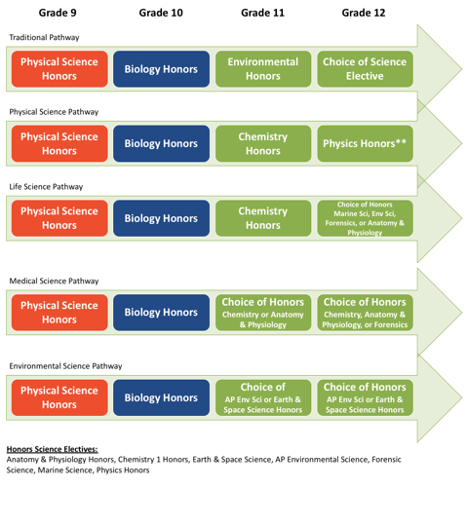Physical Science Honors (#2003320)
3 Credits Science • One of which must be Biology 1, two of which must be equally rigorous science courses • Two of the three required course credits must have a laboratory component • Industry Certifications that lead to college credit may substitute for up to one science credit (except for Biology 1) • An identified computer science** course may substitute for up to one science credit (except for Biology 1)
For students taking the course in Middle School as part of the M/J Accelerated Science Course Progression:
In order for a student to be promoted to high school from the middle grades, they must successfully complete the following courses: Three middle grades or higher* courses in science.
End of Year District Final - Counts for 10% of Final Course Grade
For High School Students:
This is an entry level science course for High School. Any grade 9 student is eligible. Teacher and student input should be considered.
For Middle School Accelerated Students:
This is the third course in the M/J Comprehensive Science Accelerated Course progression. Students should be placed based on successful completion of both M/J Comp Sci 1 & 2 Accelerated Honors in 6th and 7th grade. Teacher and student input should be considered. Student & Parent should be advised that this is a high school credit earning course and will impact GPA.
For High School Students:
M/J Comp Sci 3, M/J Comp Sci 3 Adv
For Middle School Accelerated Students:
Successful completion of both M/J Comp Sci 1 & 2 Accelerated Honors in 6th and 7th grade
HS-Biology Honors
Academic Pathways for Science
For Middle School Accelerated Students:
Student & Parent should be advised that this is a high school credit earning course and will impact GPA.
Advanced science courses include additional Next Generation Sunshine State High School Science Standards (NGSSS).
Advanced science courses will include the requirement for students to complete a scientific research project.
Access the Instructional Materials page to see approved instructional resources for this course.
Physical Science is designed for high school students needing an entry-level science course covering basic concepts found in chemistry and physics. Topics included in this study are:
matter
motion and forces
work and energy
electricity and magnetism
waves
Honors science courses include additional Next Generation Sunshine State High School Science Standards (NGSSS).
Honors science courses will include the requirement for students to complete a scientific research project.
While the content focus of this course is consistent with the Physical Science course, students will explore these concepts in greater depth. In general, the academic pace and rigor will be greatly increased for honors level course work. Laboratory investigations that include the use of scientific inquiry, research, measurement, problem solving, laboratory apparatus and technologies, experimental procedures, and safety procedures are an integral part of this course. The National Science Teachers Association (NSTA) recommends that at the high school level, all students should be in the science lab or field, collecting data every week. School laboratory investigations (labs) are defined by the National Research Council (NRC) as an experience in the laboratory, classroom, or the field that provides students with opportunities to interact directly with natural phenomena or with data collected by others using tools, materials, data collection techniques, and models (NRC, 2006, p. 3). Laboratory investigations in the high school classroom should help all students develop a growing understanding of the complexity and ambiguity of empirical work, as well as the skills to calibrate and troubleshoot equipment used to make observations. Learners should understand measurement error; and have the skills to aggregate, interpret, and present the resulting data (National Research Council, 2006, p.77; NSTA, 2007).




